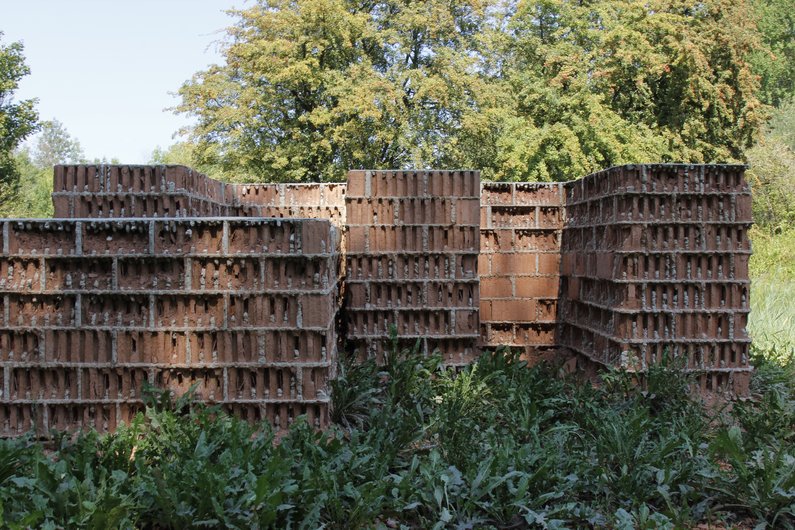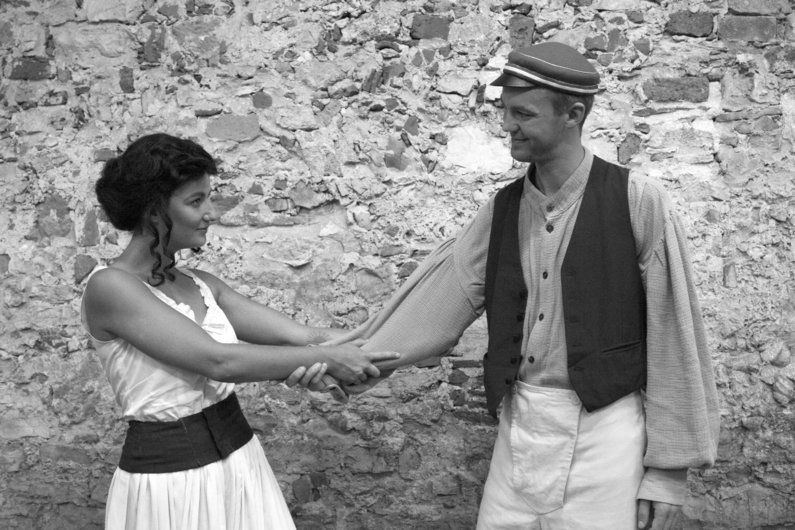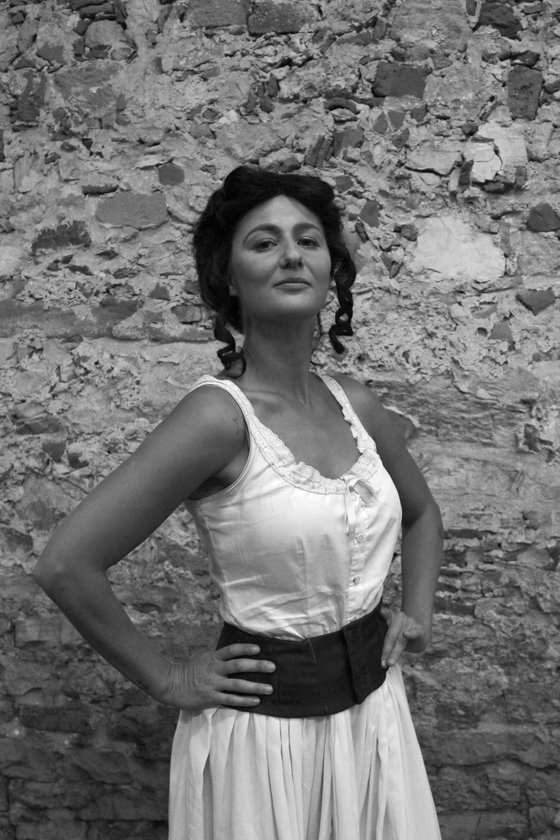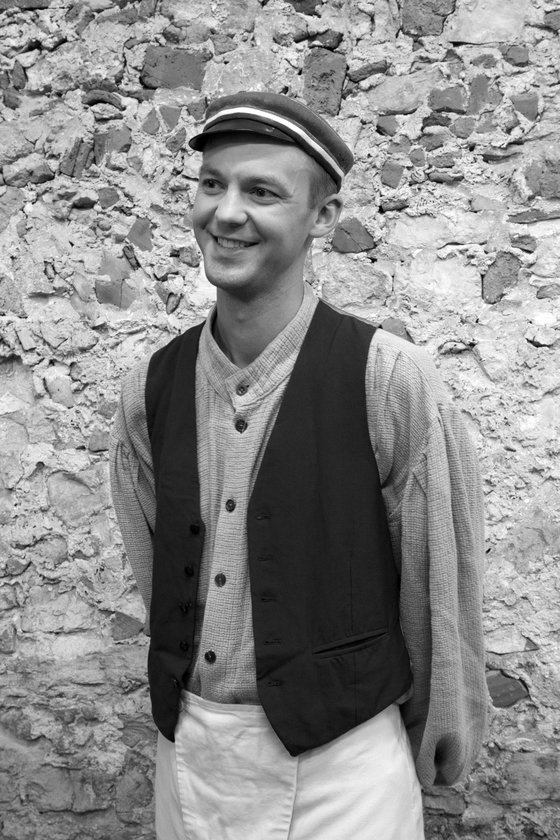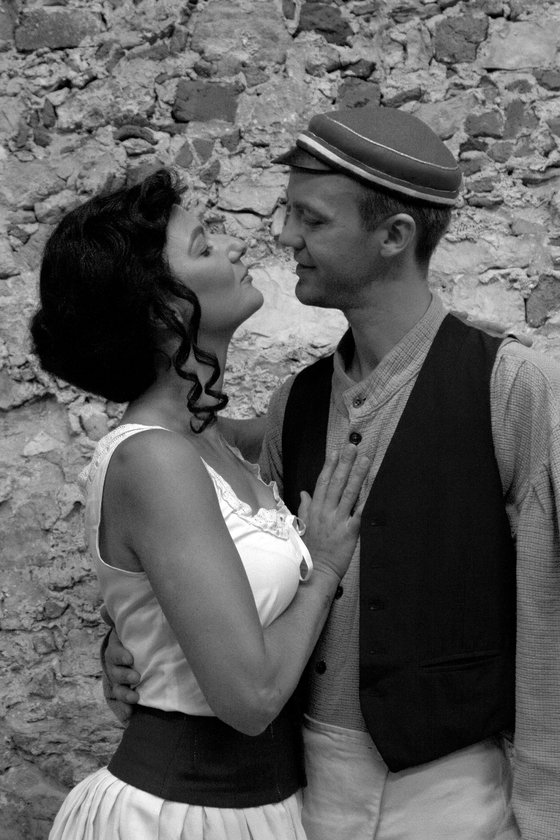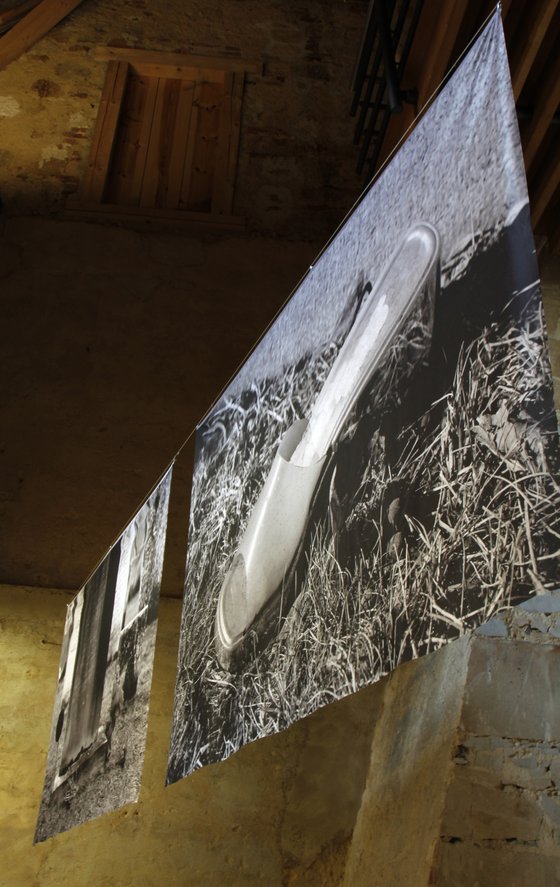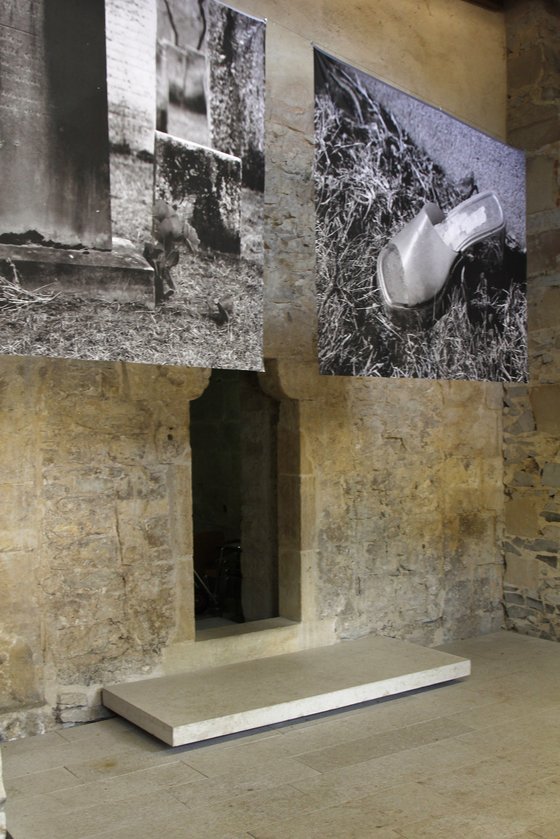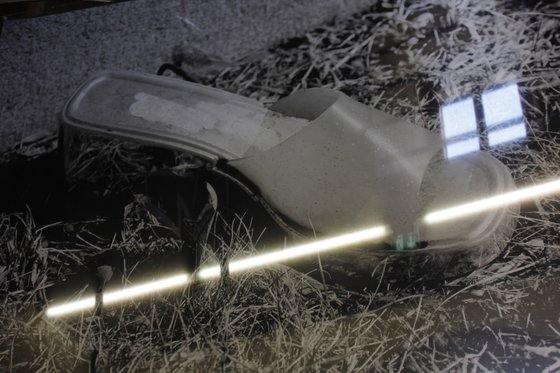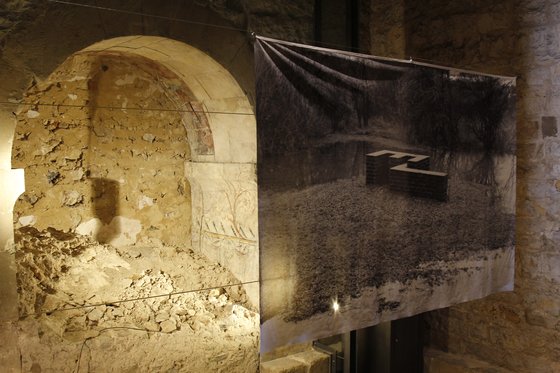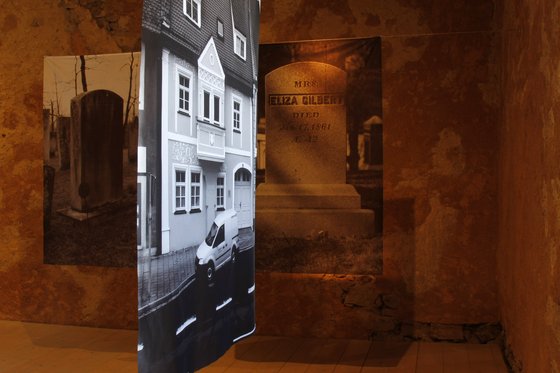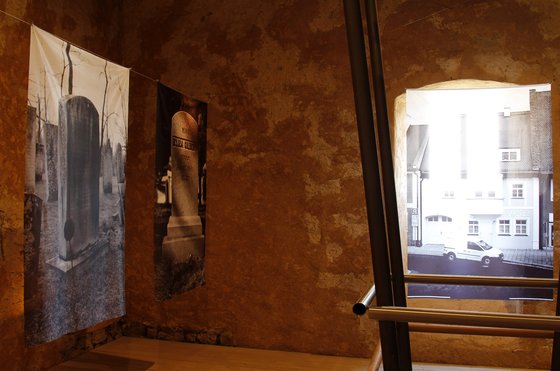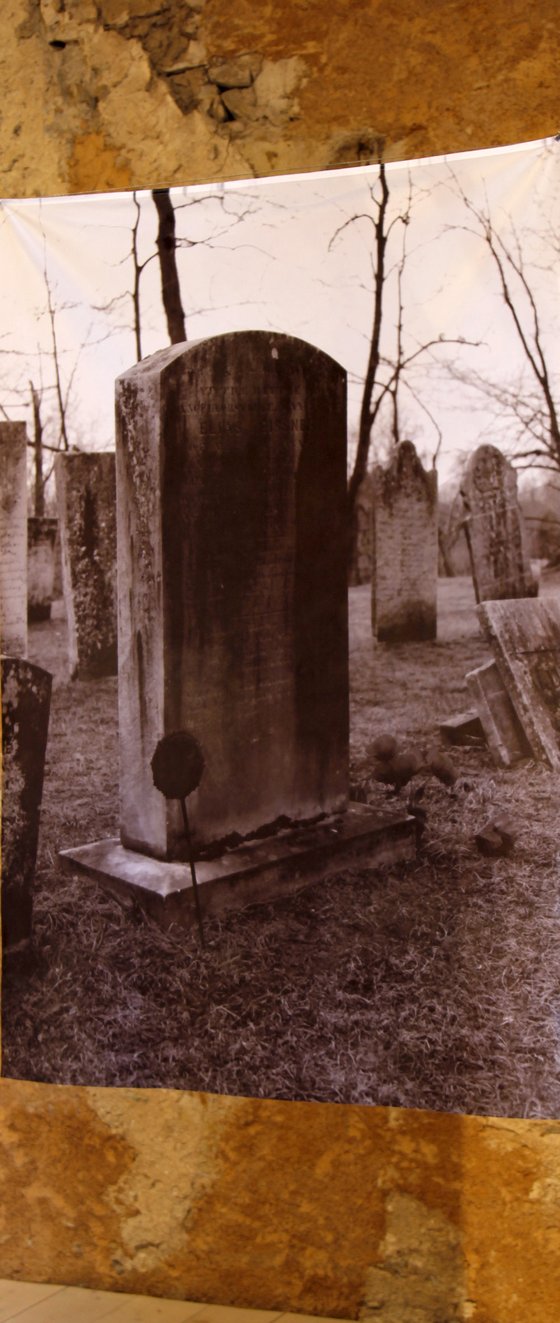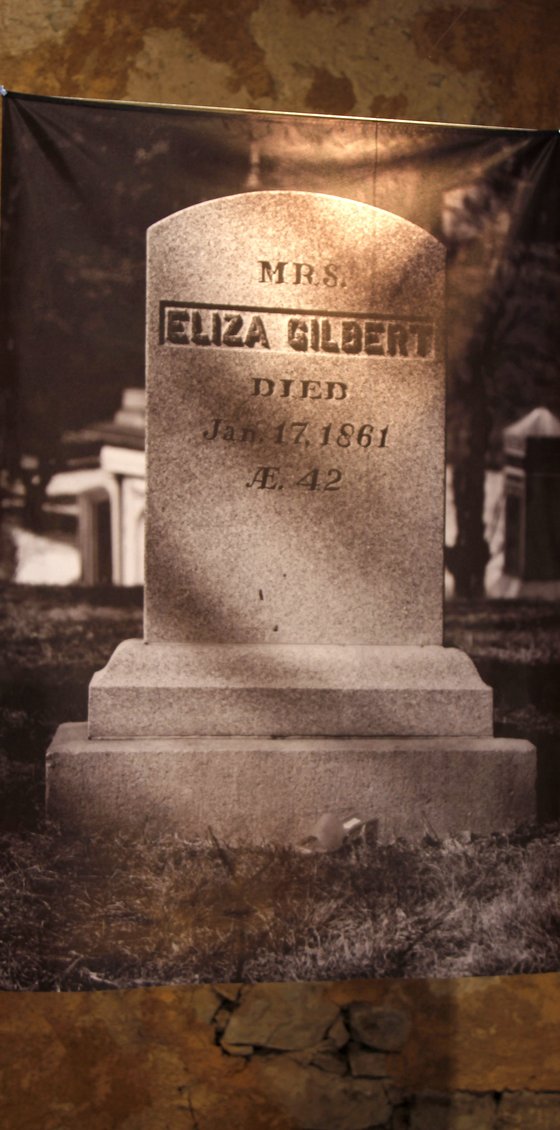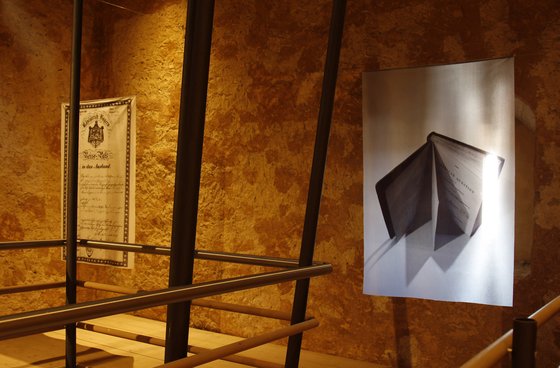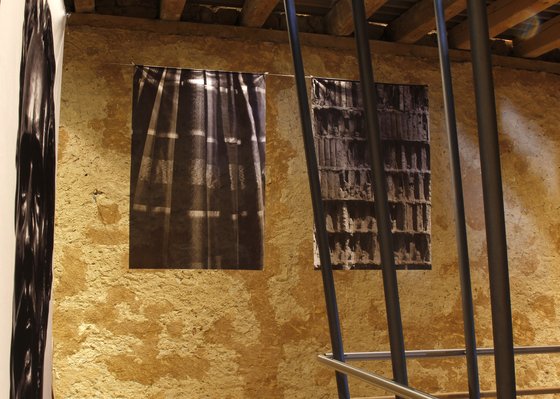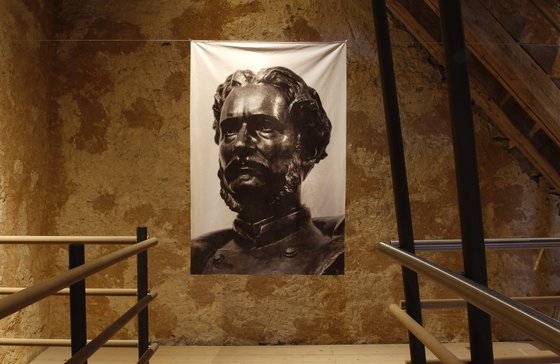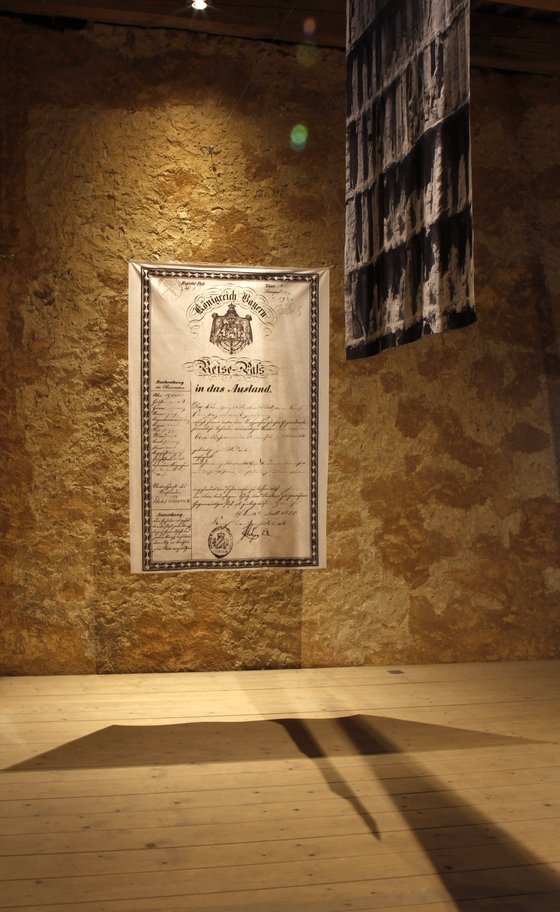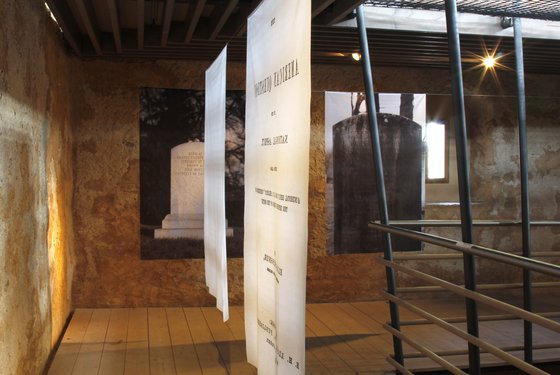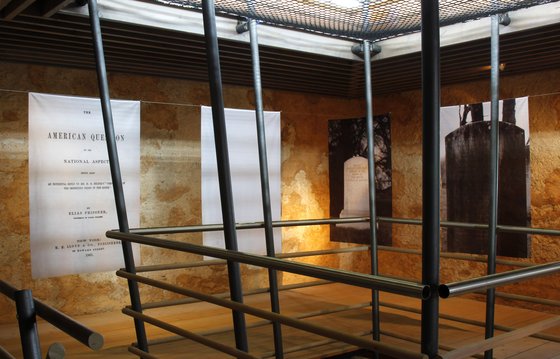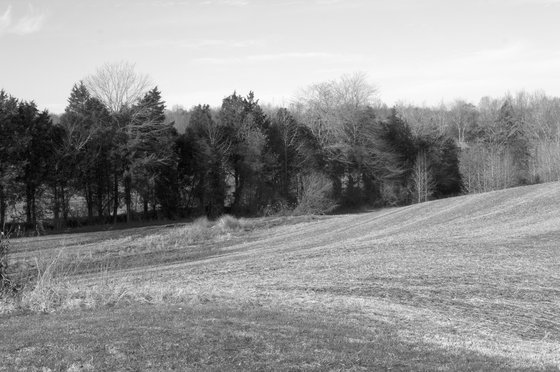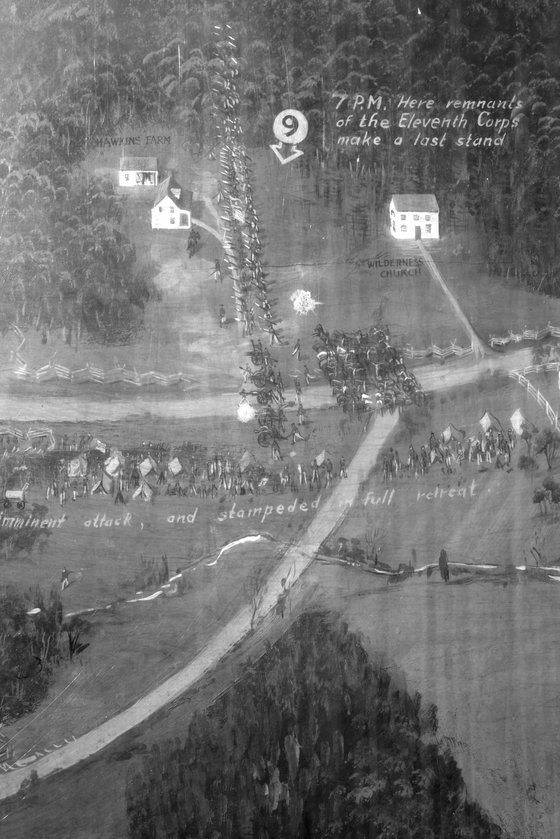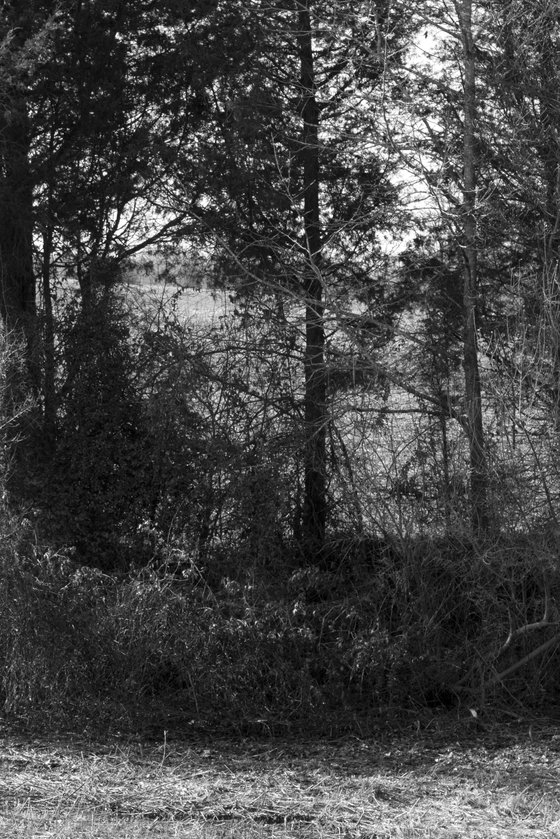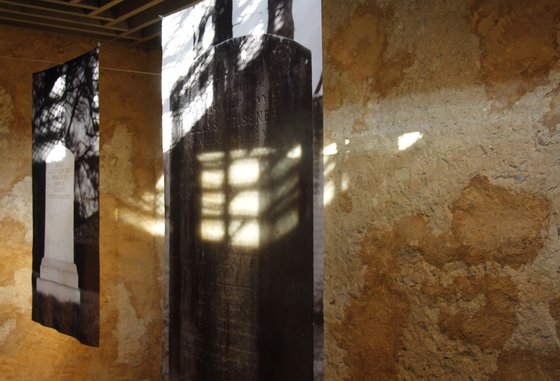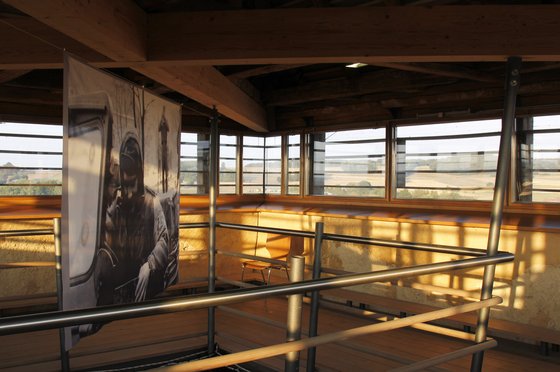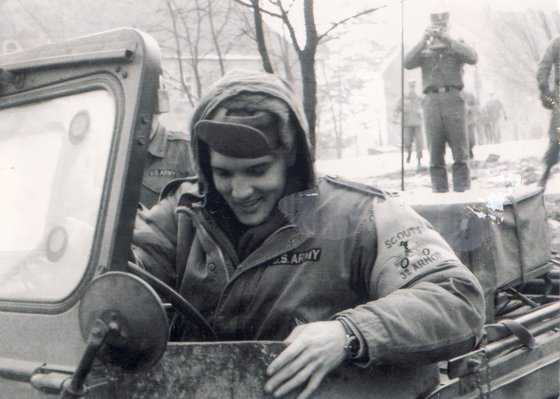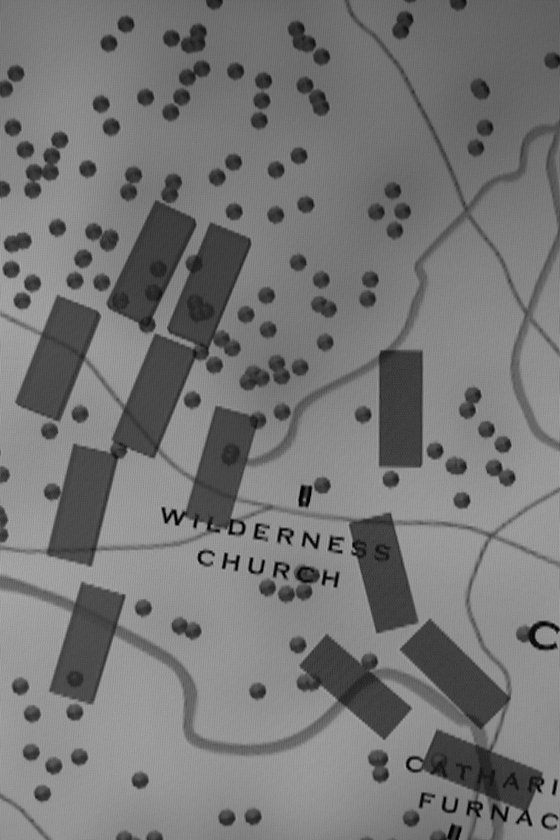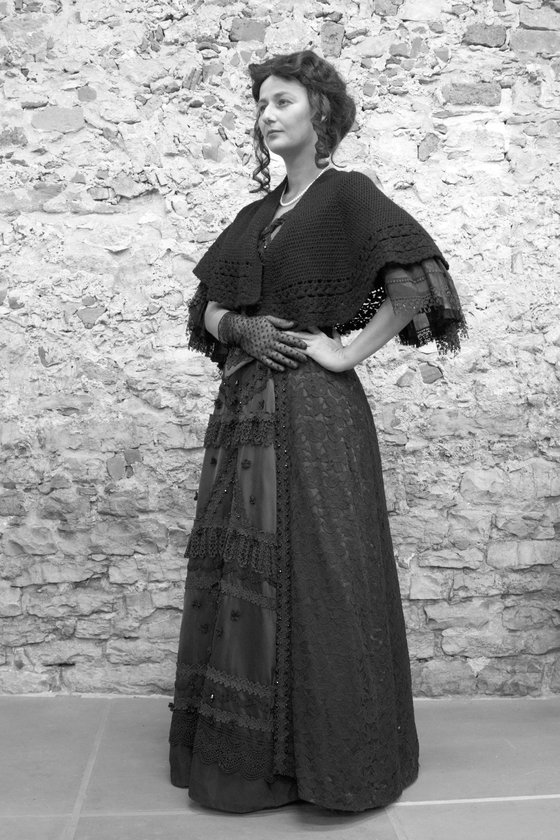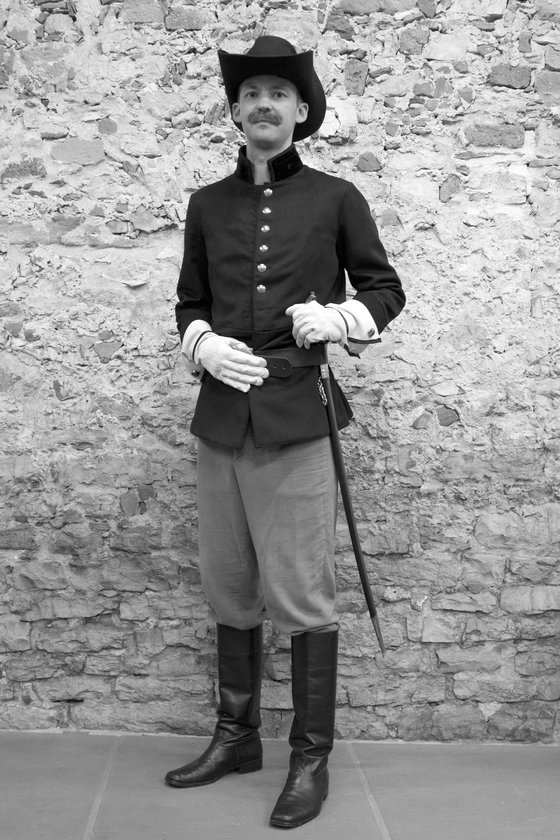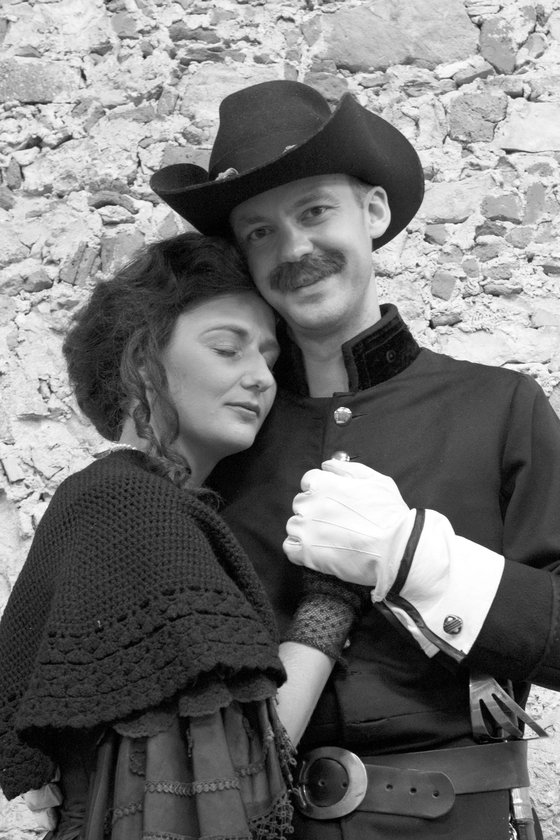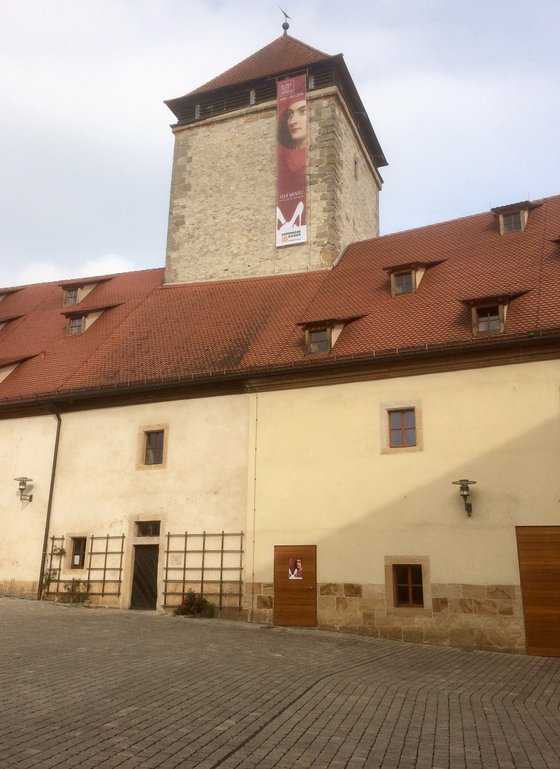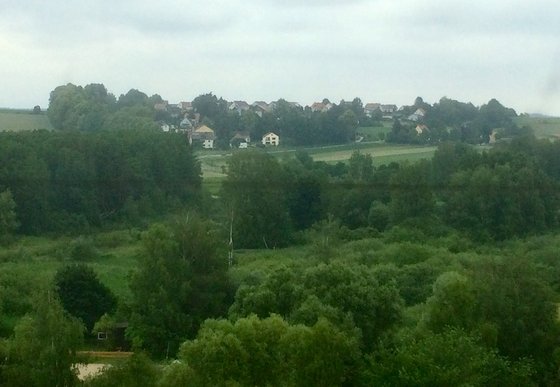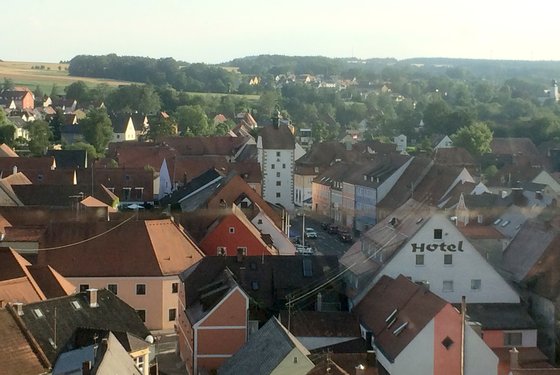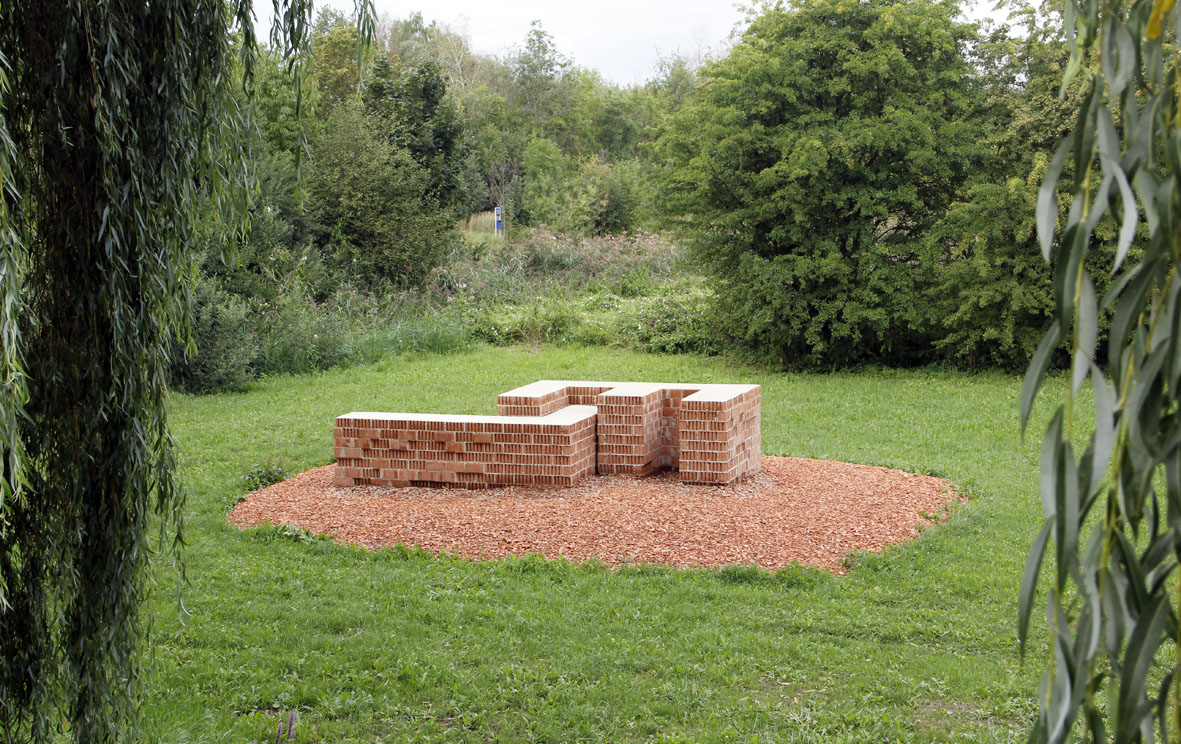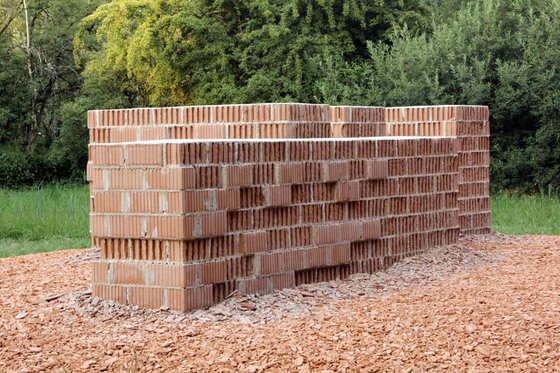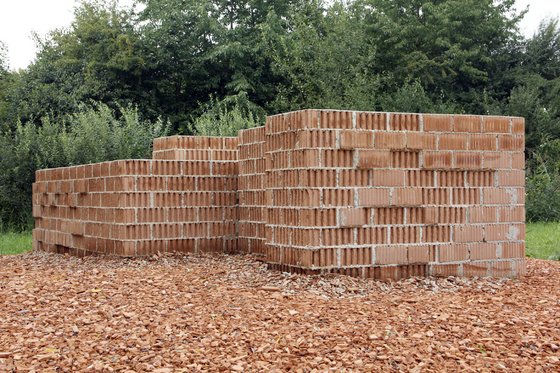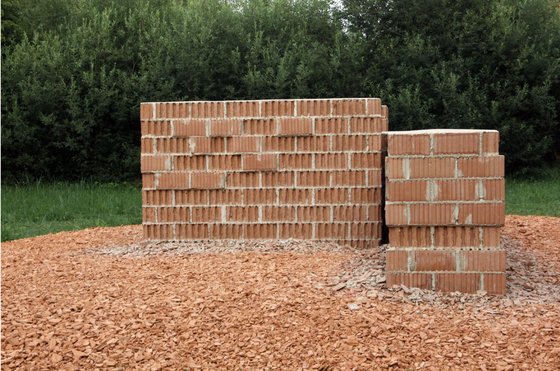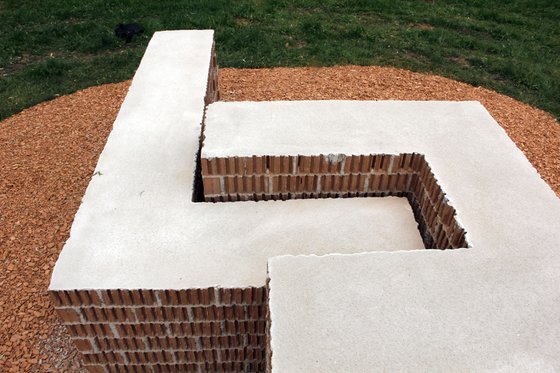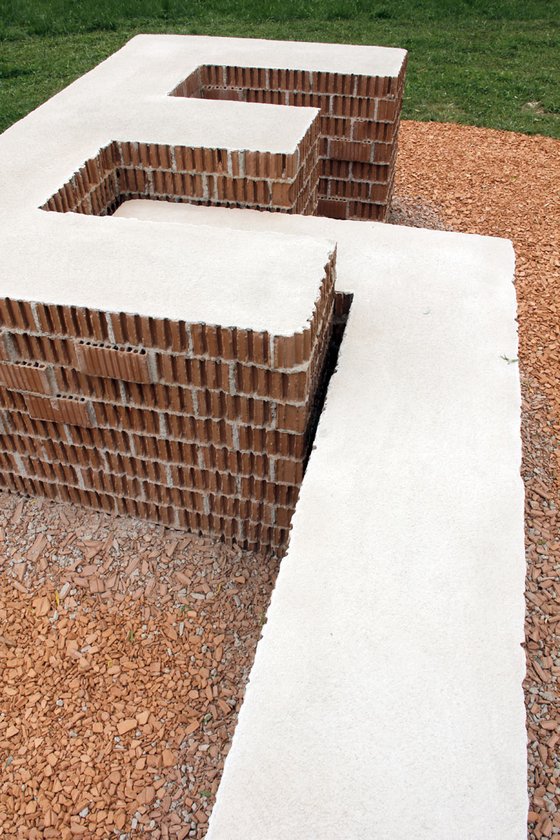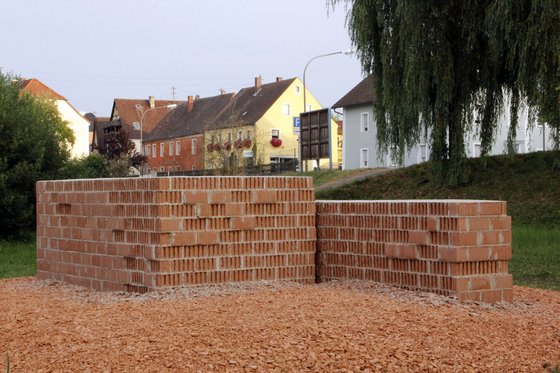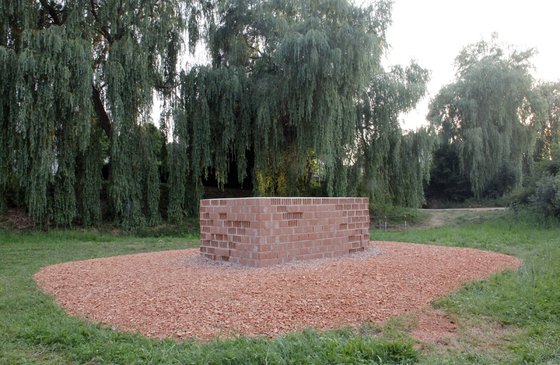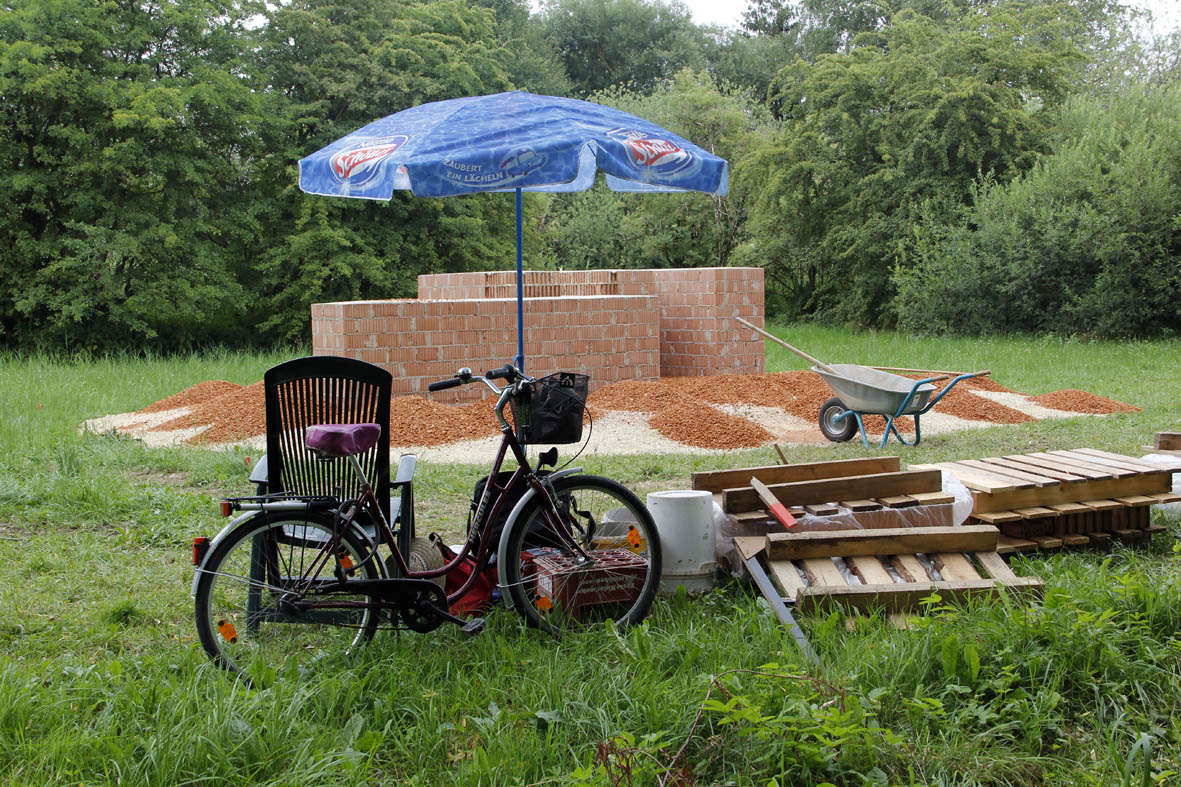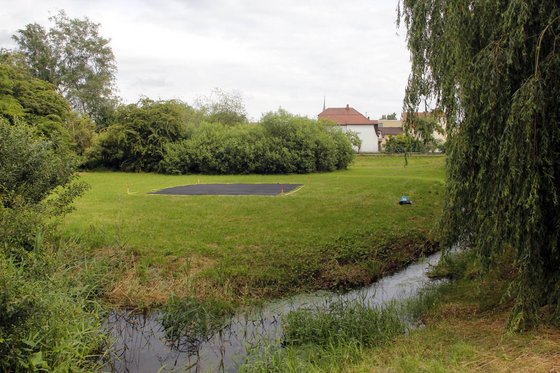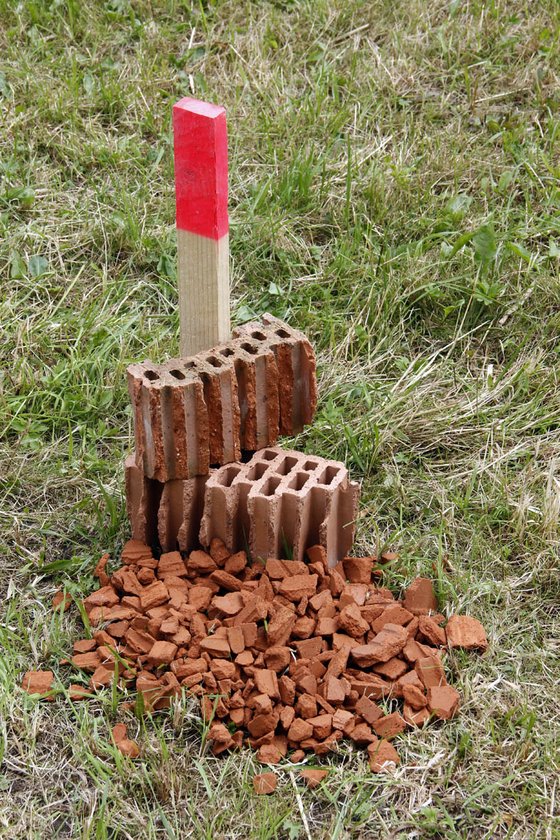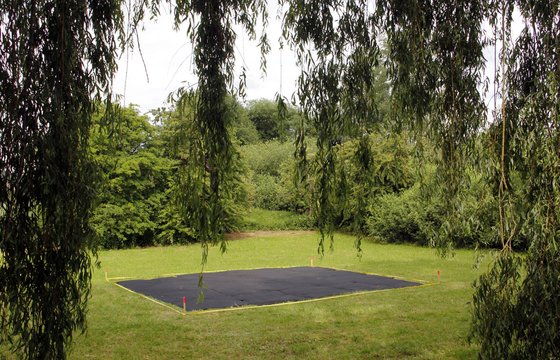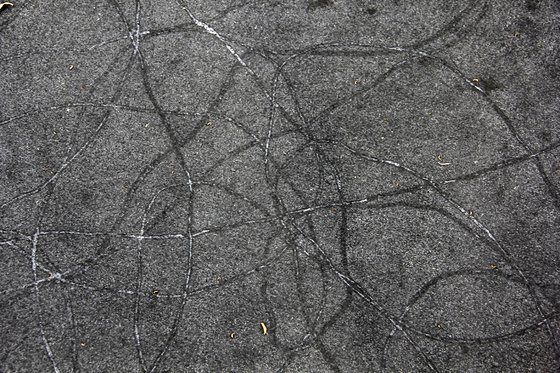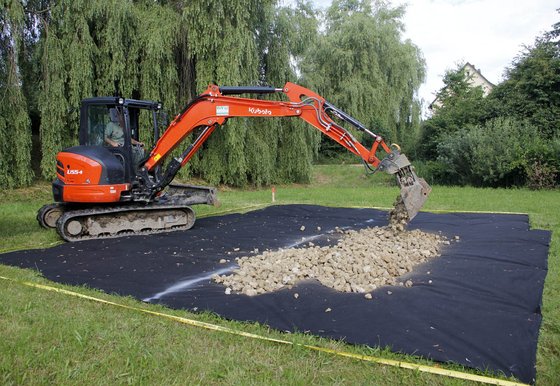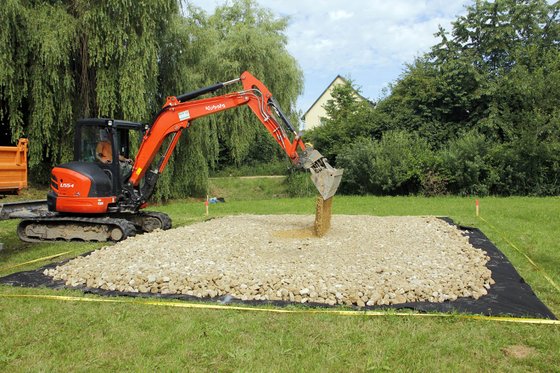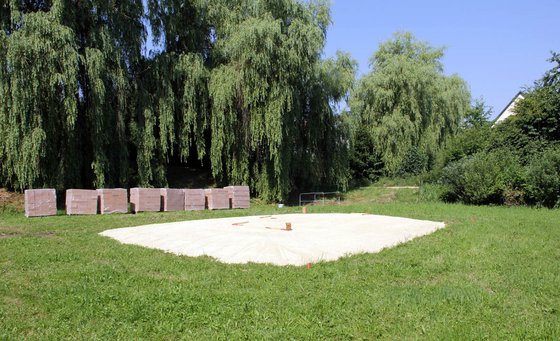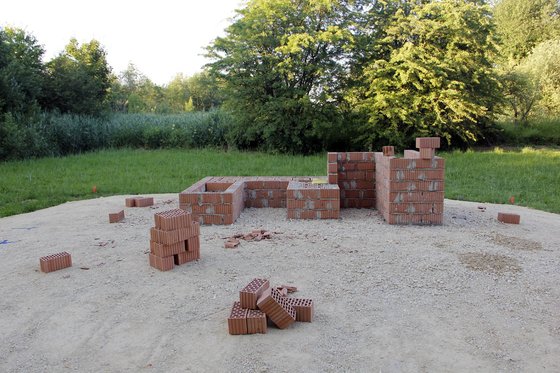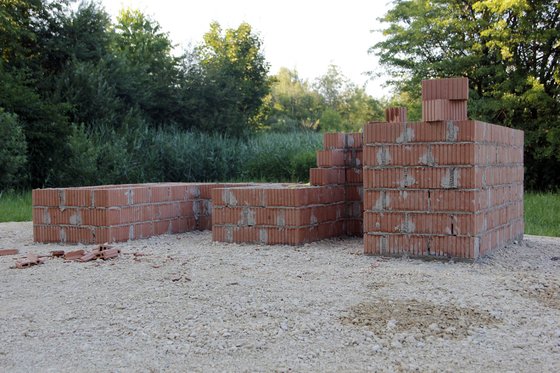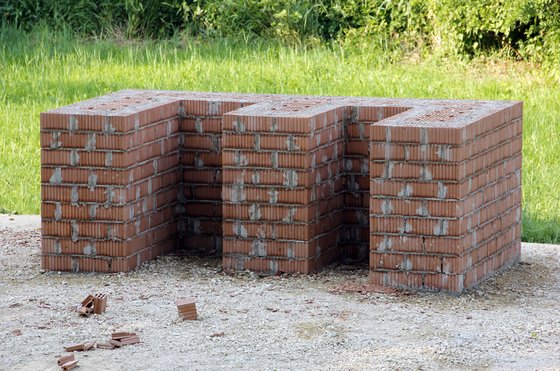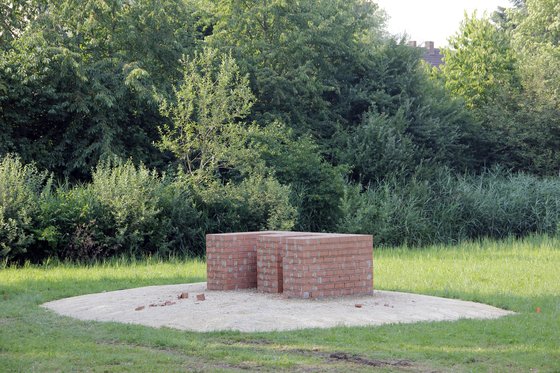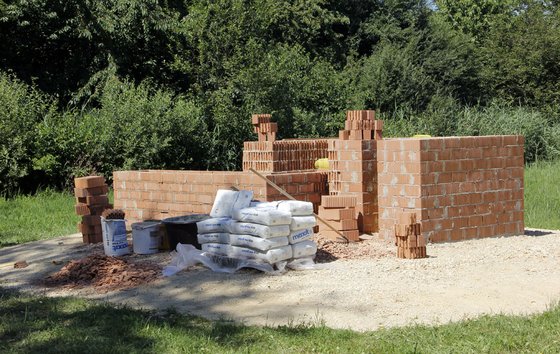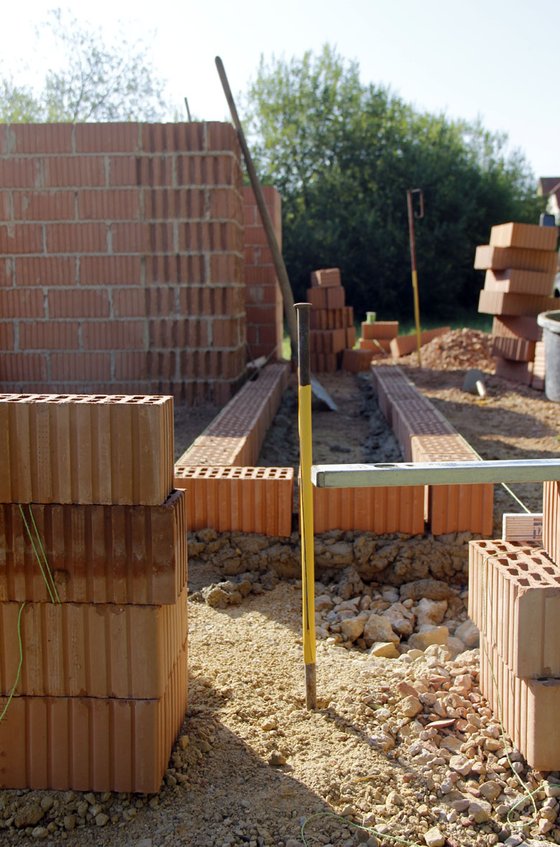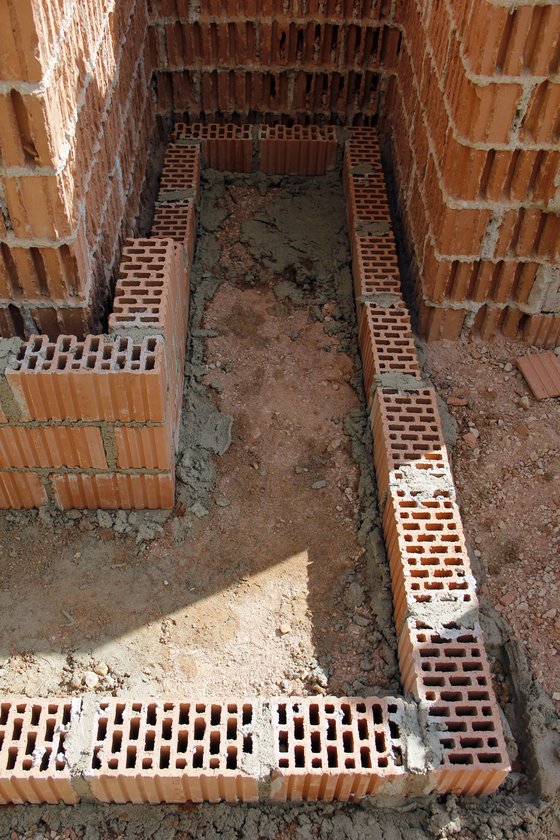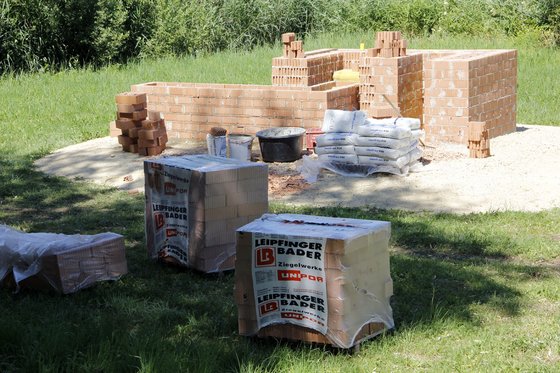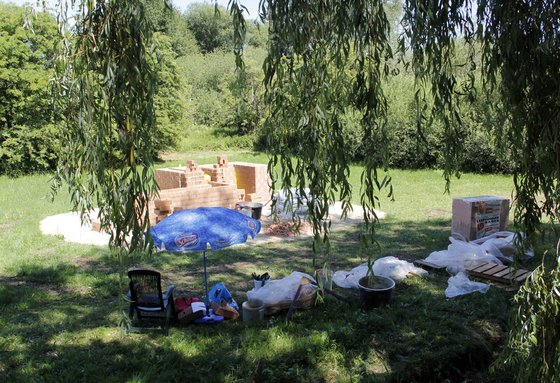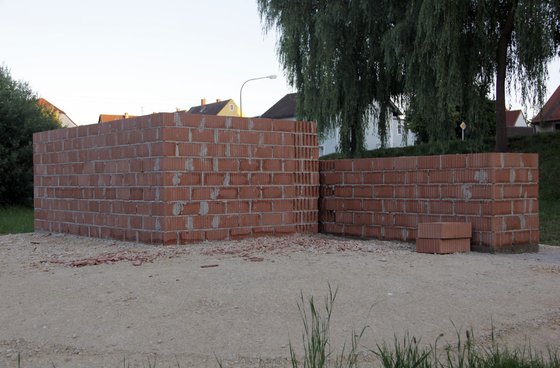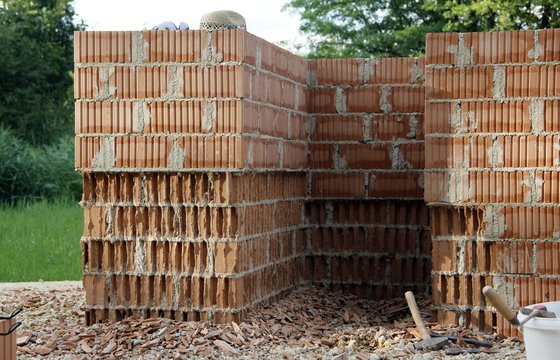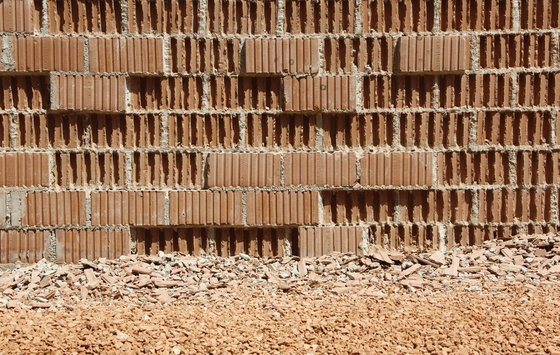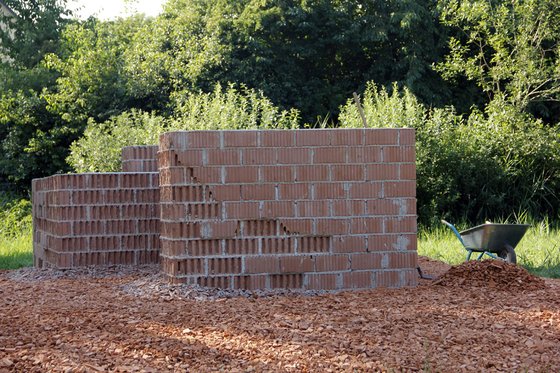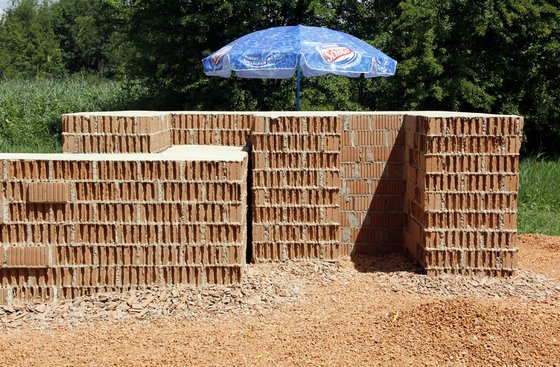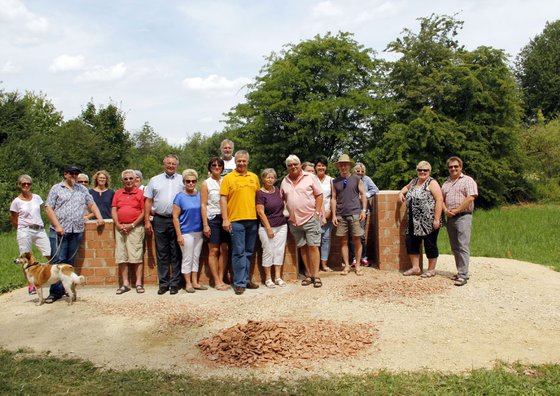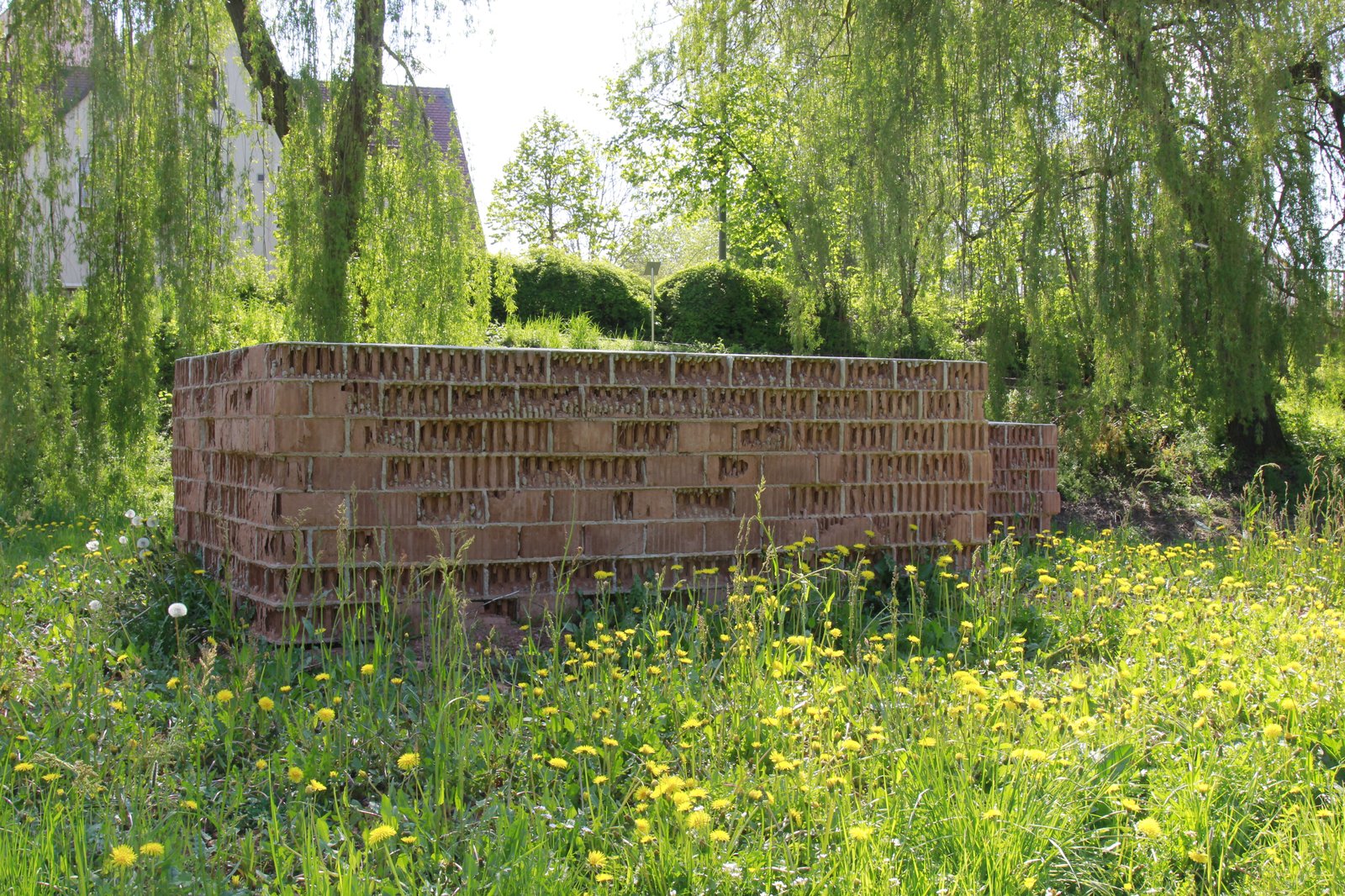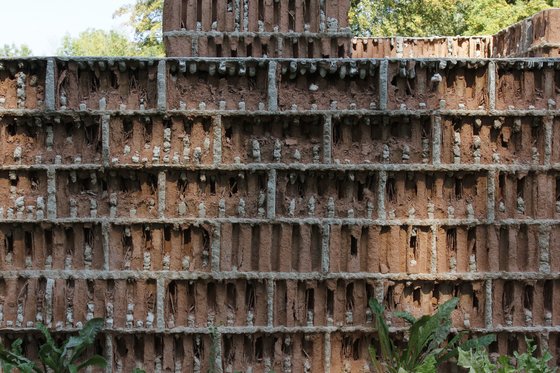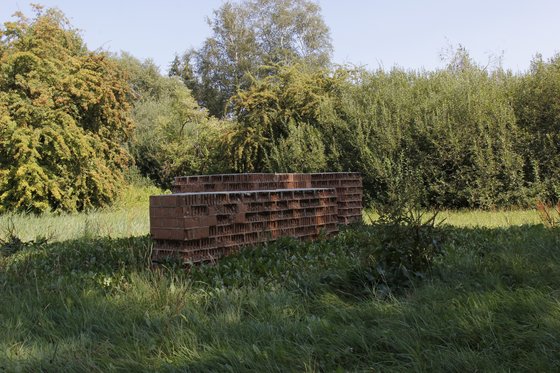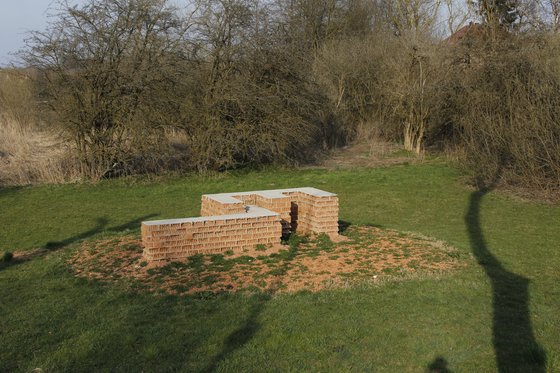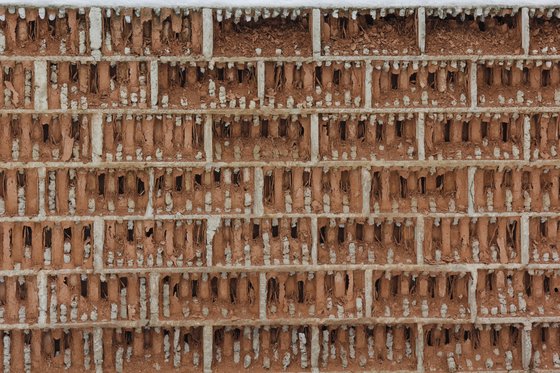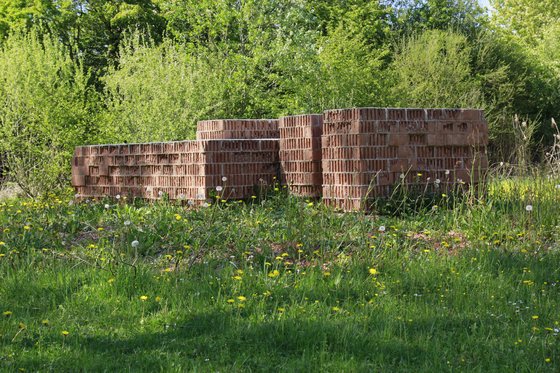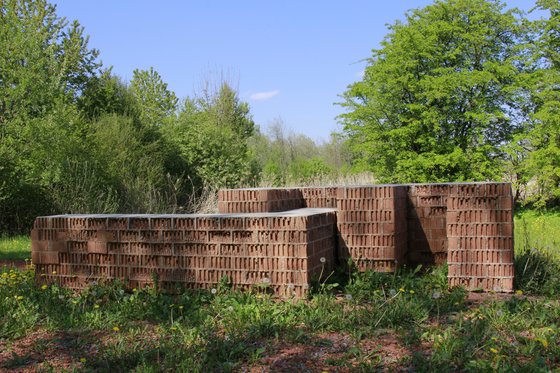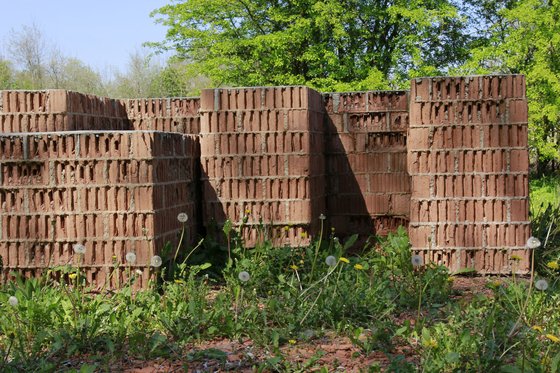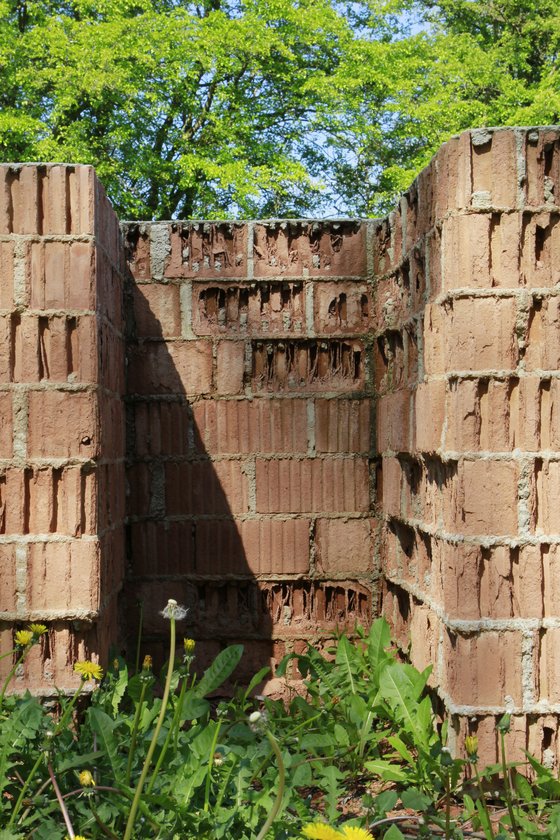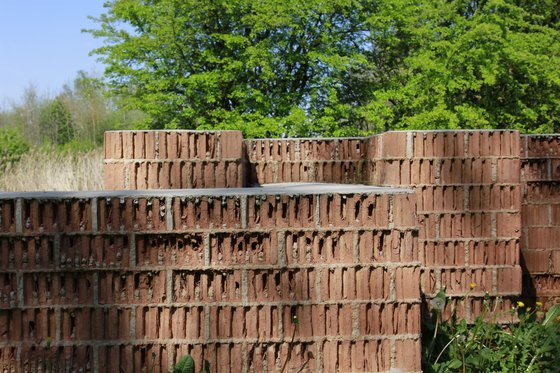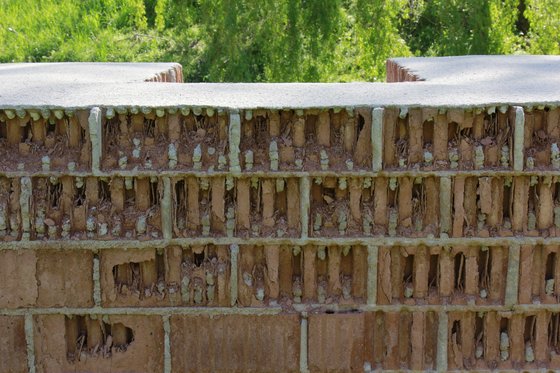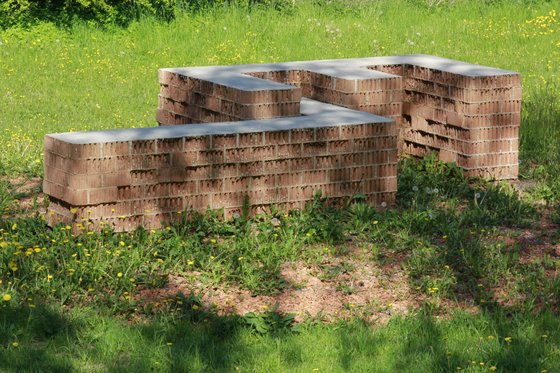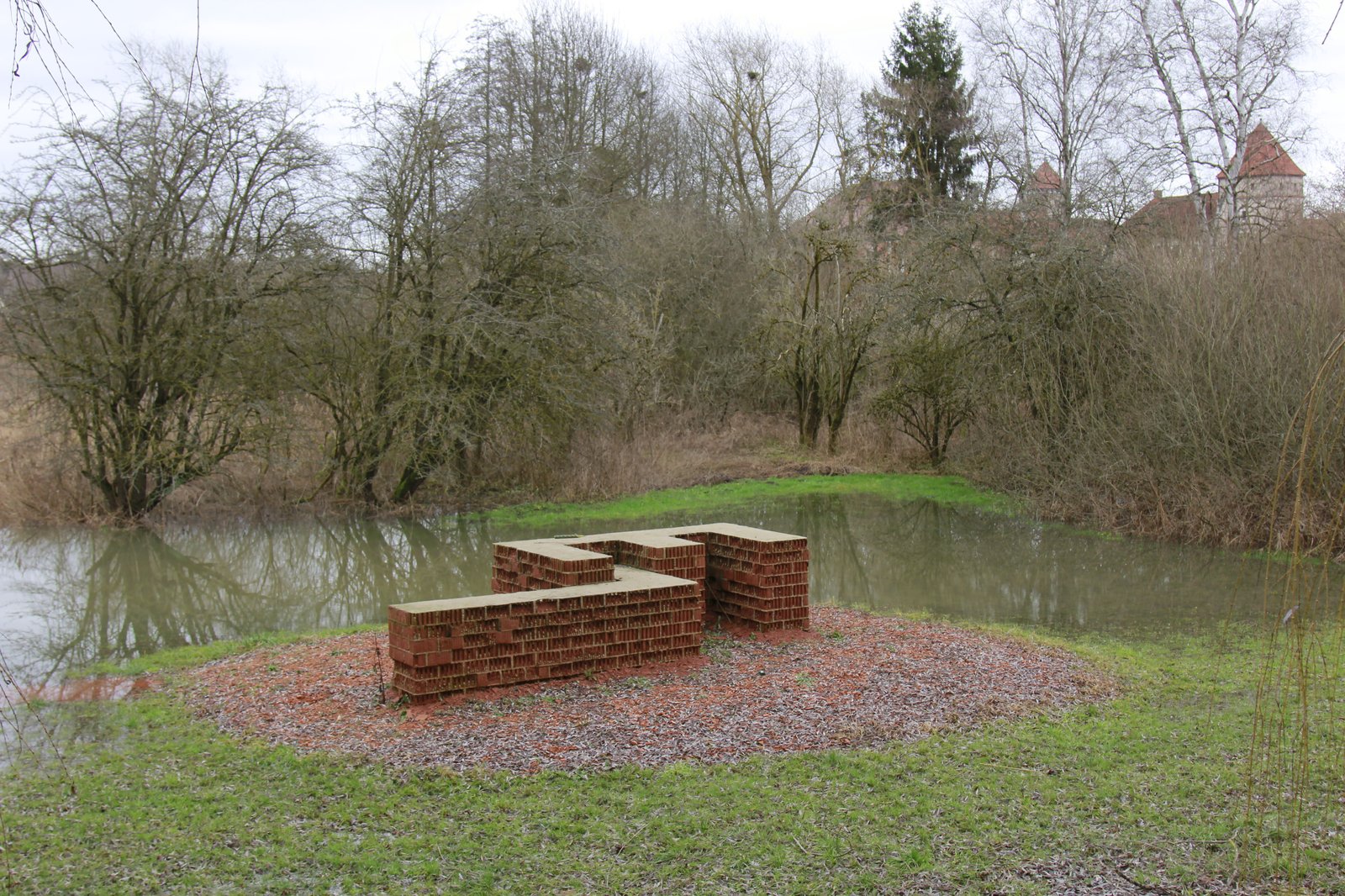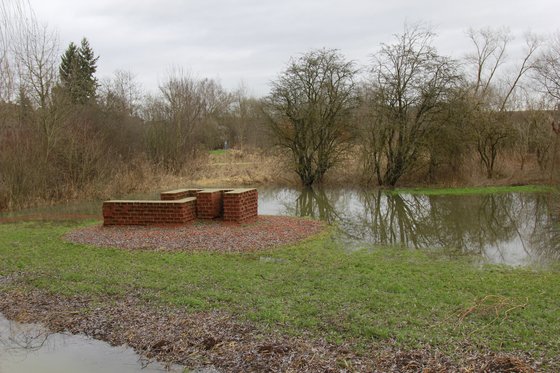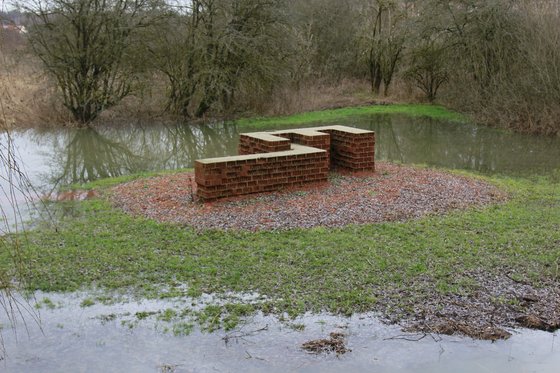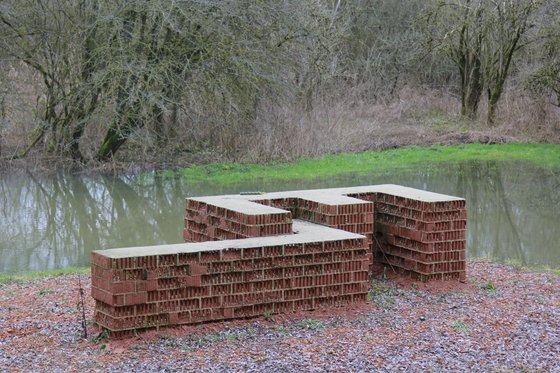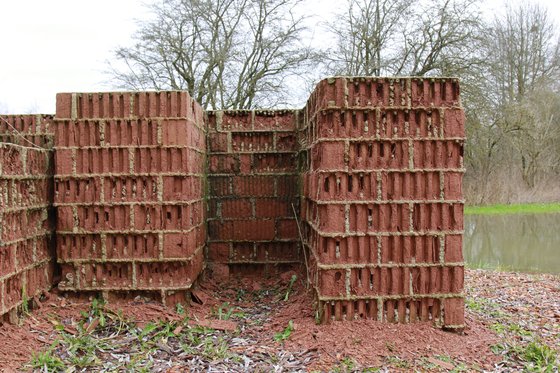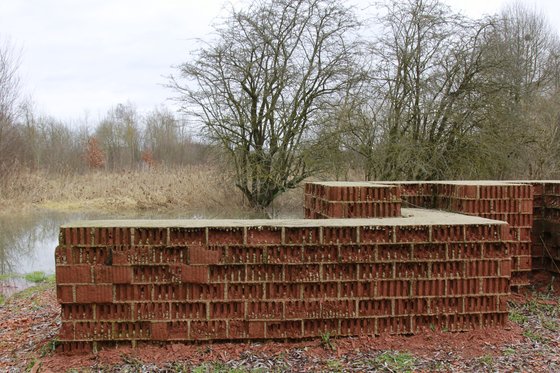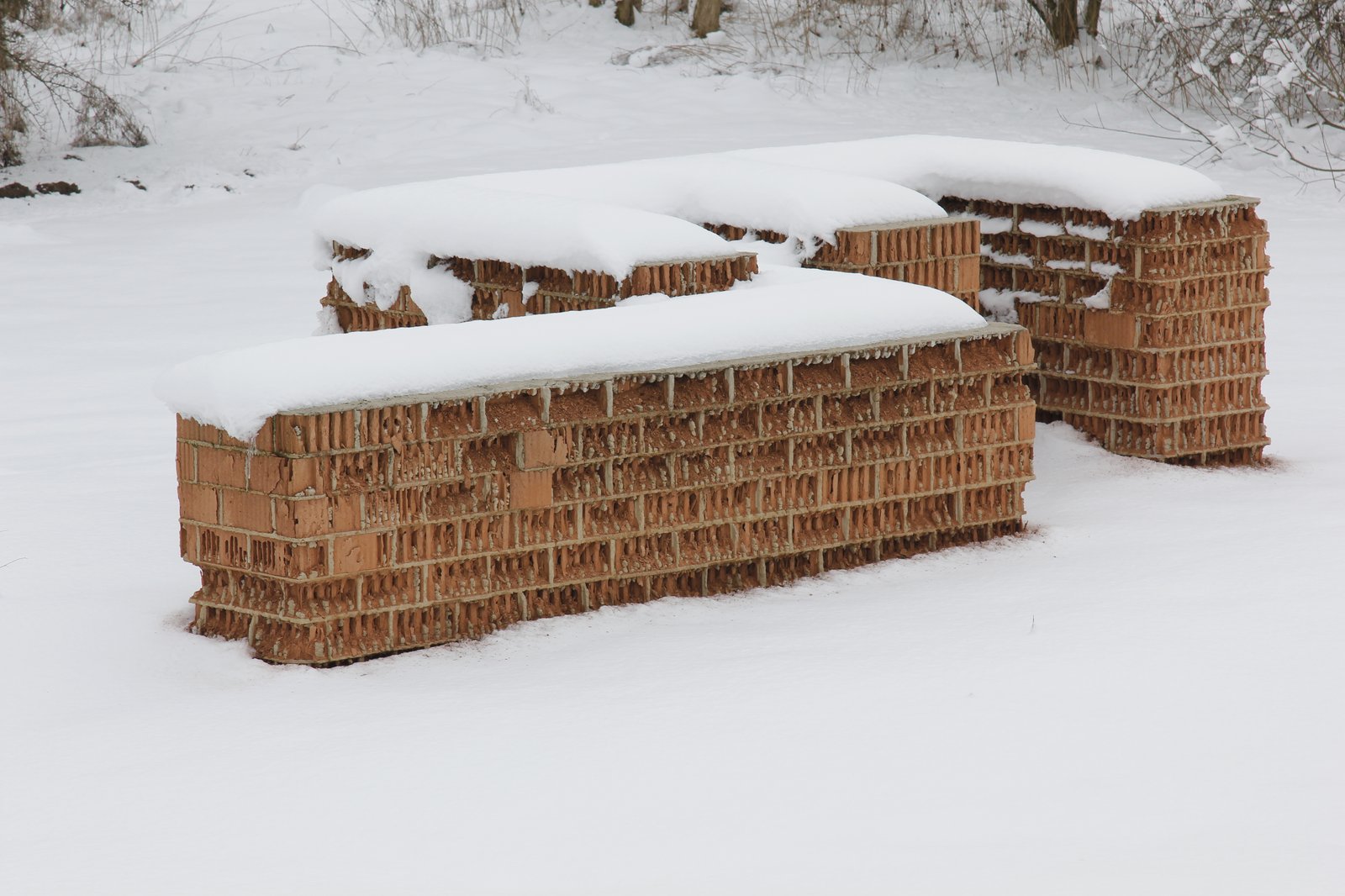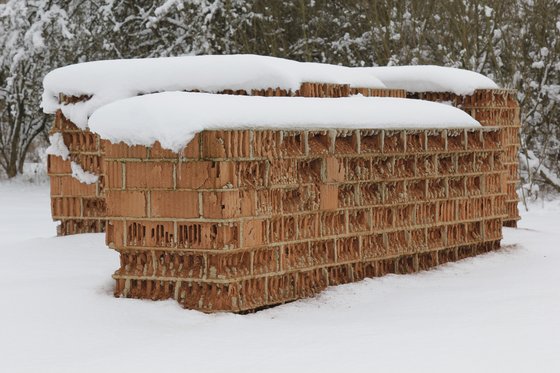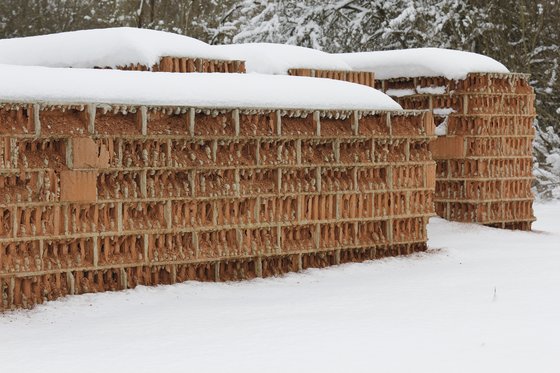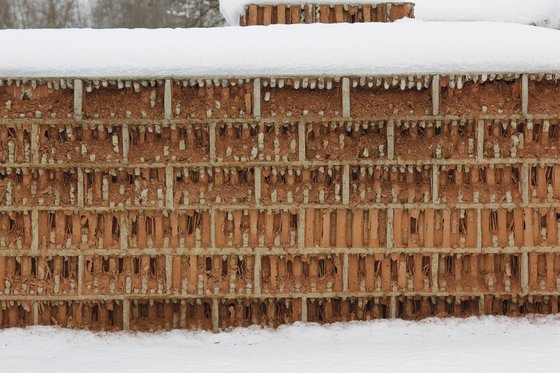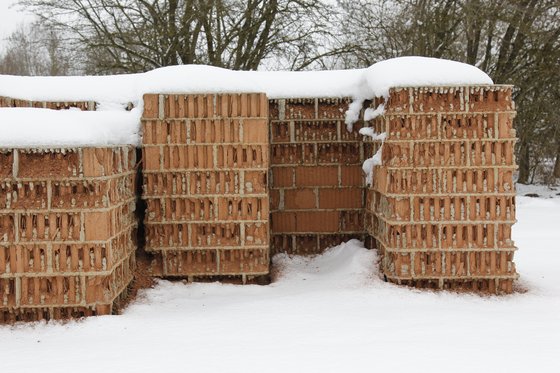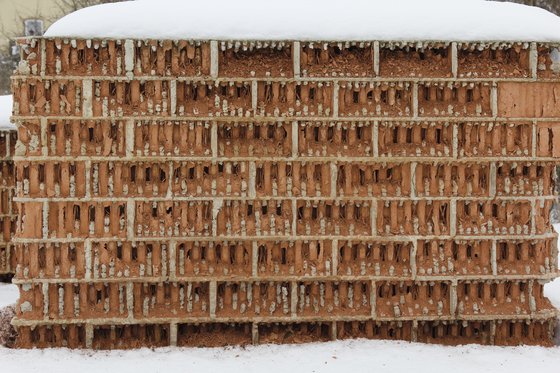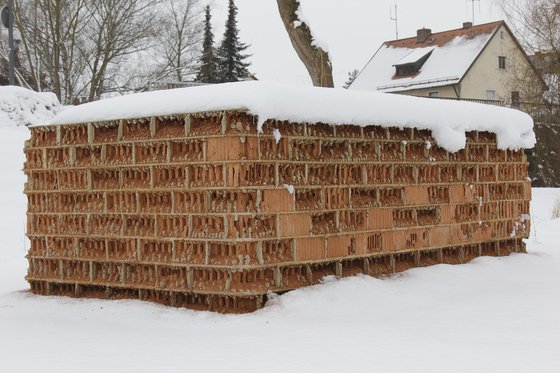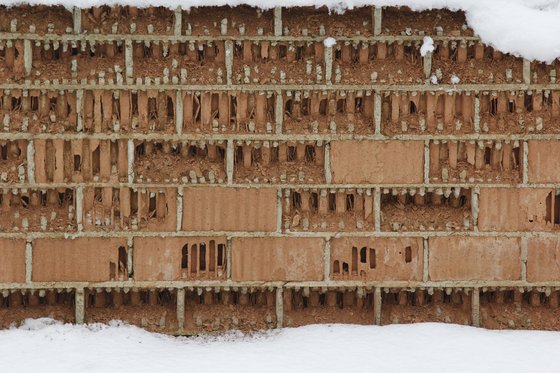Lola + Elias [+ E]
The installation “Lola + Elias [+ E]” consists of suspended large format, documentary style photographs, hanging from the different planes of castle Burg Dagestein’s main tower. The installation is a successor to the sculpture “Lola und Elias“, two oversized brick letters, “L” and “E”, which lay intertwined along the local river in the town of Vilseck. Finnish-based artist Albert Braun, born in the hometown of Elias Peißner (Vilseck, Germany), is the creator of the installation proving, in art, ideas and concepts often mature over a long period of time before they materialize. As a teenager, hearing the story of the historic love couple, Lola Montez and Elias Peißner, Albert found no personal interest in the rumours, nevertheless, they somehow remained in his subconscious.
Later on in life, Albert became fascinated by the story of the infamous lovers visit to Vilseck – the coincidental combined with physical attraction, desire, maybe also love and disappointment. The incidental moments often play a big part in the circumstances shaping our world. The more one investigates the story of both Lola and Elias, the more complex it becomes: the careers of the two before and after leaving Germany, Elias’ participation in the American Civil War and his commitment against slavery, or the mark Lola left on Broadway. The connections between the United States and Vilseck and other, more vague, echoes of the couple’s lives in our time.
The installation "Lola + Elias [+ E]” wants to awaken the imagination of its spectators, and spark an interest in the story of Lola and Elias. But what or who hides behind the mysterious [+ E]?
Lola Montez: Barbara Trottmann, Elias Peißner: Patrik Götz (actors)
LOLA MONTEZ, Die falsche Spaniern, Burgfestspiele Vilseck, Germany, 2018
Thoughts on Albert Braun’s exhibition (translation: Sara Braun)
The installation “Lola + Elias [+ E]” consists of suspended large format, documentary style photographs, hanging from the different planes of castle Burg Dagestein’s main tower. The installation is a successor to the sculpture “Lola und Elias“, two oversized brick letters, “L” and “E”, which lay intertwined along the local river in the town of Vilseck. Finnish-based artist Albert Braun, born in the hometown of Elias Peißner (Vilseck, Germany), is the creator of the installation proving, in art, ideas and concepts often mature over a long period of time before they materialize. As a teenager, hearing the story of the historic love couple, Lola Montez and Elias Peißner, Albert found no personal interest in the rumours, nevertheless, they somehow remained in his subconscious.
Later on in life, Albert became fascinated by the story of the infamous lovers visit to Vilseck – the coincidental combined with physical attraction, desire, maybe also love and disappointment. The incidental moments often play a big part in the circumstances shaping our world. The more one investigates the story of both Lola and Elias, the more complex it becomes: the careers of the two before and after leaving Germany, Elias’ participation in the American Civil War and his commitment against slavery, or the mark Lola left on Broadway. The connections between the United States and Vilseck and other, more vague, echoes of the couple’s lives in our time.
In preparation for the art project, Albert Braun visited both grave sites, Lola’s in Greenwood cemetery in New York City and Elias’s in Schenectady, New York. While there, Albert approached various people and Union College, that still to this day remembers Elias with an annual prize in his name.
The installation "Lola + Elias [+ E]” wants to awaken the imagination of its spectators, and spark an interest in the story of Lola and Elias. But what or who hides behind the mysterious [+ E]?
Who were Elias and Lola?
Elias Peißner was born in Vilseck on September 5th, 1825 to the town’s tower-guard, Jakob Peißner, and his wife Katharina Barbara (born Kotzbauer). He had eight siblings and lived with his family in the “Wünnenberghaus”, a picturesque townhouse with a bay window on Marktplatz 20 in Vilseck. During his studies of philosophy and law at the university of Munich, Elias founded the fraternity “Allemania”. It is also in Munich where he and Lola Montez met for the first time on June 18th, 1847.
Lola Montez and her relationship with King Ludwig I is known through history. Her scandalous performances as a Spanish dancer and her entaglement with King Ludwig I and the tower-guard’s son Elias, causes turmoil in Munich and all over Bavaria. Within a few months the 25 year old femme fatale Lola succeeds in shaking the foundations of the Bavarian monarchy. She became the catalytic trigger of a revolution, one that turned middle class reformed ideas into Bavarian law. Similar fights for democratic causes were fought all over Europe in 1848. In Munich, the revolution came to a quick and bloodless end, Lola Montez is expelled from the big city and soon afterwards, on March 20th, 1848, King Ludwig I abdicates. The king does not want to give in to the demands of the Democratic-Liberal revolutionaries, and was disputed as a king after his affair with the scandalous dancer.
On February 11th, 1848, under the eyes of an angry population, Lola flees in a carriage, from Munich to Castle Blutenburg, where she spends the night with her lover and accomplice, the student Elias Peißner. According to local rumours, Elias helped Lola escape by bringing her to his birthplace, the townhouse in Vilseck. The Vilseckers claimed that a horse carriage with two men in student attire arrived at the Vilseck marketplace, apparently Elias accompanied by a classmate. But soon the fugitive masked as a student was identified as Lola. There is indeed a few days in-between March 9th and 15th,1848, during which the whereabouts of Lola are unknown. She left Munich in the early dawn on March 9th, and in mid-March she met up with Elias in Frankfurt am Main. So it would be quite possible that she, for a couple of days during her getaway, found shelter at the Peißner family.
In the “Erstes Deutsches Türmer Museum” ("Germany’s First Tower-Guard Museum”) in Vilseck, a dress is exhibited that is said to have been left behind by Lola at the family home of Elias Peißner. It is verified that Jakob Peißner, Elias’ father, was promoted, through the advocacy of Lola Montez, to the position of government messenger under the reign of King Ludwig I. Elias Peißner continued his law studies in Gießen, outside of Bavaria, with financial support from the King. Later on Elias emigrated incognito to the United States.
On July 3rd, 1849, Elias Peißner arrives in New York. He became a professor of German language and literature at the prestigious Union College in Schenectady, New York. In the United States, Elias Peißner was best known for his publications, which include various linguistic essays and his famous, headstrong writing “The American Question in the National Aspect”, talking about a non-violent abolition of slavery. In 1861 Elias Peißner put together the volunteer unit “the Union College Zouaves”, and went to war as Colonel of the 119th New York Regiment. On May 2, 1863 Elias Peißner died from a fatal wound in the Battle of Chancellorsville, Virginia.
How did Lola’s life unfold? After fleeing Bavaria, Lola Montez first lived in exile in Switzerland. In 1849, she returned to England, where she left behind her "memoirs”, published in 1851, as a sort of European testament, before emigrating to America. In February 1851 she moved to New York and starred in the Broadway show "Lola Montez in Bavaria”, then toured the West Coast, invented “the Spider Dance" and, after having had rotten eggs thrown at her during one of her performances, retired to the California gold rush town of Grass Valley, where she kept a grizzly bear as a pet.
In 1855 Lola Montez went on tour in Australia, as time went on dancing became increasingly difficult for her and she faced problems as an aging actress – she moved on to holding readings and lectures. In 1858 she published her books "The Arts of Beauty”, in which she gives practical tips on hygiene and beauty care with recipes for natural cosmetics, and later in the same year “Anecdotes of Love” is published. She became involved with social issues for so-called "fallen girls". In 1859 she spent a short time giving lectures in London, but returned to America. On June 30, 1860, after a stroke, Lola Montez was partially paralyzed. She passed away due to pneumonia on January 17, 1861, shortly before her 40th birthday. She is buried at Greenwood Cemetery in Brooklyn, New York.
The town of Vilseck continues to preserve the memory of Lola and Elias. Vilseck has named a street after the famous son of the town’s tower-guard, and attached a plaque outside of his birthplace. In the “Türmermuseum” you can see the ancestral tree of the Peißner family and the travel gown that Lola Montez allegedly left in Vilseck. Time and time again both Lola and Elias are remembered during guided tours of Vilseck.
LOLA + ELIAS
Brick Sculpture
Plzen 2015 European Capital of Culture, Art Trail Vilsaue, Vilseck, Germany, 2015
This is a memorial for love, peace and freedom. It is made out of shortened bricks that form together a sculpture with two over-dimensional letters. The letter E stands for Elias Peissner and the letter L for Lola Montez. These two letters as are intertwined, reminding us of an embrace between two lovers. The surface of the bricks is on purpose broken, making them lively and vulnerable.
The sculpture refers to a relationship between Elias and Lola, son of city tower guard & mistress of King Ludwig I, dating to the year of 1848. A pair of lovers who not only wrote the history of the city of Vilseck, but also made an impact on the history of the München area and also on the Civil War in USA. Another possible name for the sculpture could have been: Peace and Love.
Links:
Kunstpfad Vilseck
